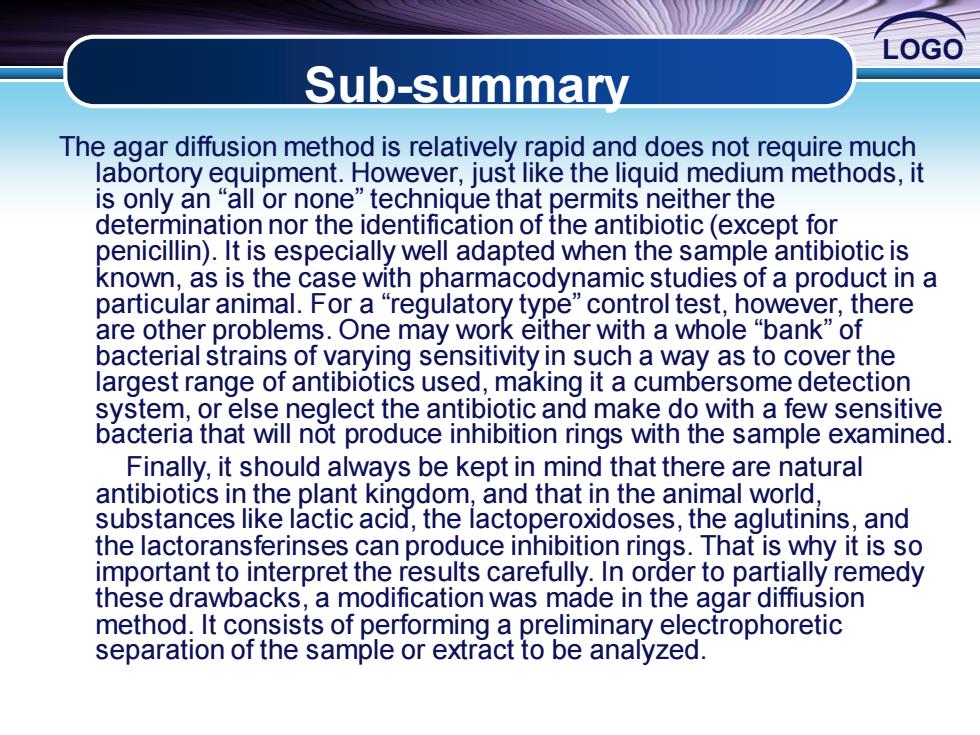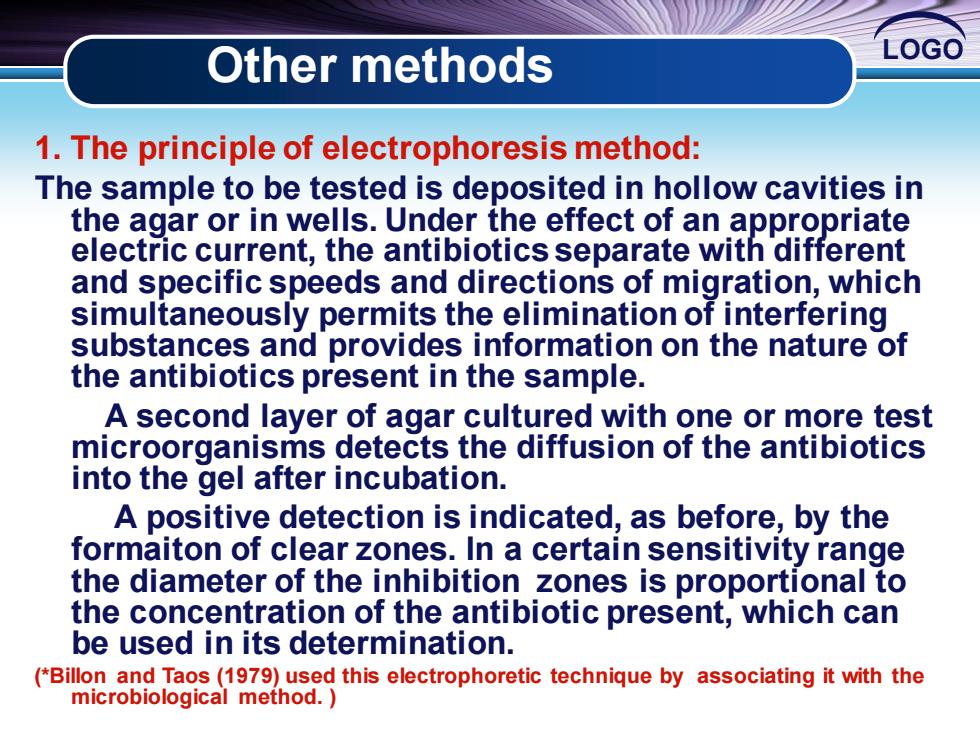
LOGO Procedure 1.The agar medium,which is melted and then cooled to 45C,is cultured with a diluted suspension of the test germ.It is homogenized and the mixture is poured into Petri dishes left to cool horizontally.After pasteurization,the sample is aseptically placed in contact with the agar according to two techniques: 2.A filter paper disk is saturated with a fraction of the sample product or the extraction solution (in this case,drying is very important),and then deposited on the surface of the cultured agar; 3.The sample is placed into hollow cavities in the agar or small stainless steel cylinders applied to the agar surface
LOGO 1. The agar medium, which is melted and then cooled to 45℃, is cultured with a diluted suspension of the test germ. It is homogenized and the mixture is poured into Petri dishes left to cool horizontally. After pasteurization, the sample is aseptically placed in contact with the agar according to two techniques: 2. A filter paper disk is saturated with a fraction of the sample product or the extraction solution (in this case, drying is very important), and then deposited on the surface of the cultured agar; 3. The sample is placed into hollow cavities in the agar or small stainless steel cylinders applied to the agar surface. Procedure

Interpretation of Results LOGO Petri dishes prepared as discussed are incubated.A clear zone around the filter papar disk or the cavity indicates the presence of a substance in the sample with antibiotic activity.Otherwise,colonies propagate through the entire agar surface.A control must always be performed with a preparation that does not contain antibiotics.It is important that this test be conducted under conditions that are rigorously identical to the sample biological liquid.Most biological products(e.g.,serum,liver,milk, muscle,urine,etc.)have enzyme binding or destructive properties thar are likely to distort the results.It is possible to detect penicillin by performing an assay with a disk saturated with penicillinase.If the sample contains penicillin at the start,then no inhibition zone appears around the disk saturated with penicillinase.If it contains an antibiotic other than penicillin,then an inhibition zone appears around the disk saturated with penicillinase
LOGO Petri dishes prepared as discussed are incubated. A clear zone around the filter papar disk or the cavity indicates the presence of a substance in the sample with antibiotic activity. Otherwise, colonies propagate through the entire agar surface. A control must always be performed with a preparation that does not contain antibiotics. It is important that this test be conducted under conditions that are rigorously identical to the sample biological liquid. Most biological products (e.g., serum, liver, milk, muscle, urine, etc.) have enzyme binding or destructive properties thar are likely to distort the results. It is possible to detect penicillin by performing an assay with a disk saturated with penicillinase. If the sample contains penicillin at the start, then no inhibition zone appears around the disk saturated with penicillinase. If it contains an antibiotic other than penicillin, then an inhibition zone appears around the disk saturated with penicillinase. Interpretation of Results

LOGO Sub-summary The agar diffusion method is relatively rapid and does not require much labortory equipment.However,just like the liquid medium methods,it is only an"all or none"technique that permits neither the determination nor the identification of the antibiotic(except for penicillin).It is especially well adapted when the sample antibiotic is known,as is the case with pharmacodynamic studies of a product in a particular animal.For a"regulatory type"control test,however,there are other problems.One may work either with a whole "bank"of bacterial strains of varying sensitivity in such a way as to cover the largest range of antibiotics used,making it a cumbersome detection system,or else neglect the antibiotic and make do with a few sensitive bacteria that will not produce inhibition rings with the sample examined. Finally,it should always be kept in mind that there are natural antibiotics in the plant kingdom,and that in the animal world. substances like lactic acid,the lactoperoxidoses,the aglutinins,and the lactoransferinses can produce inhibition rings.That is why it is so important to interpret the results carefully.In order to partially remedy these drawbacks,a modification was made in the agar diffiusion method.It consists of performing a preliminary electrophoretic separation of the sample or extract to be analyzed
LOGO The agar diffusion method is relatively rapid and does not require much labortory equipment. However, just like the liquid medium methods, it is only an “all or none” technique that permits neither the determination nor the identification of the antibiotic (except for penicillin). It is especially well adapted when the sample antibiotic is known, as is the case with pharmacodynamic studies of a product in a particular animal. For a “regulatory type” control test, however, there are other problems. One may work either with a whole “bank” of bacterial strains of varying sensitivity in such a way as to cover the largest range of antibiotics used, making it a cumbersome detection system, or else neglect the antibiotic and make do with a few sensitive bacteria that will not produce inhibition rings with the sample examined. Finally, it should always be kept in mind that there are natural antibiotics in the plant kingdom, and that in the animal world, substances like lactic acid, the lactoperoxidoses, the aglutinins, and the lactoransferinses can produce inhibition rings. That is why it is so important to interpret the results carefully. In order to partially remedy these drawbacks, a modification was made in the agar diffiusion method. It consists of performing a preliminary electrophoretic separation of the sample or extract to be analyzed. Sub-summary

Other methods LOGO 1.The principle of electrophoresis method: The sample to be tested is deposited in hollow cavities in the agar or in wells.Under the effect of an appropriate electric current,the antibiotics separate with different and specific speeds and directions of migration,which simultaneously permits the elimination of interfering substances and provides information on the nature of the antibiotics present in the sample. A second layer of agar cultured with one or more test microorganisms detects the diffusion of the antibiotics into the gel after incubation. A positive detection is indicated,as before,by the formaiton of clear zones.In a certain sensitivity range the diameter of the inhibition zones is proportional to the concentration of the antibiotic present,which can be used in its determination. (*Billon and Taos(1979)used this electrophoretic technique by associating it with the microbiological method
LOGO 1. The principle of electrophoresis method: The sample to be tested is deposited in hollow cavities in the agar or in wells. Under the effect of an appropriate electric current, the antibiotics separate with different and specific speeds and directions of migration, which simultaneously permits the elimination of interfering substances and provides information on the nature of the antibiotics present in the sample. A second layer of agar cultured with one or more test microorganisms detects the diffusion of the antibiotics into the gel after incubation. A positive detection is indicated, as before, by the formaiton of clear zones. In a certain sensitivity range the diameter of the inhibition zones is proportional to the concentration of the antibiotic present, which can be used in its determination. (*Billon and Taos (1979) used this electrophoretic technique by associating it with the microbiological method. ) Other methods